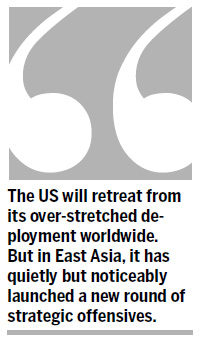International Ties
East Asia in reconstruction
By Yang Danzhi (China Daily)
Updated: 2010-10-29 07:57
 |
Large Medium Small |

Entry of US and Russia into East Asia Summit will turn the organization into a platform where big powers compete
The established equilibrium and political order in East Asia are undergoing delicate changes at a time when the world is sill struggling to recover from the effects of the global financial crisis and its ensuing repercussions.
Such changes stem from strategic adjustments in the East Asia policy of the United States. As the world's dominant power, the US has long been the most important external factor affecting East Asia's political and economic landscape.
Washington's attitude toward East Asian cooperation has always been consistent. It will remain as an observer if the cooperation process does not pose a threat to what it views as its own vested interests in the region. However, once cooperative momentum is considered a challenge to its national interests, the US will intervene and stop the process. This was clearly embodied in Washington's efforts to suffocate the East Asia Economic Sphere concept proposed by Malaysia and the East Asian Monetary Fund advocated by Japan in the 1990s.
East Asian cooperation has made substantial progress and entered a crucial stage since the Sept 11 attacks in 2001 diverted the focus and resources of the US to the war in Afghanistan and Iraq. What the US currently cares about most in the region is getting a share of the dividend created by the accelerated integration in East Asia, and at the same time, guarding against a possible challenge by some emerging regional powers to US dominance.
The strength of the US has been weakened by the global financial crisis and it will gradually retreat from its over-stretched strategic deployment worldwide. But in East Asia, the US has quietly but noticeably launched a new round of strategic offensives.
By signing the Treaty of Amity and Cooperation with Southeast Asian countries, the US has actively involved itself in a series of forums spearheaded by the Association of Southeast Asian Nations (ASEAN) and the Mekong River Commission conferences. Washington has also staged a string of bilateral and multilateral military exercises with some East Asian allies in a bid to strengthen already-established alliances. Washington has also shown great enthusiasm toward participating in East Asian cooperation in a wider and deeper manner.
Russia, now on the way to rejuvenation, has once again shown great interest in participating in East Asian cooperation. Senior Russian officials have on different occasions claimed that Moscow's strategic interests in the Asia-Pacific region allow no disrespect and countries should not underestimate Russia's role and importance in resolving political, energy, environmental and other key issues in the Asia-Pacific region.
Due to disagreements among ASEAN members, Russia has previously been excluded from the East Asian cooperation process.
At the ASEAN Foreign Ministers' Meeting in Hanoi, Vietnam, on July 20, the decision was made to expand the East Asia Summit to include the US and Russia. The two countries are expected to become formal members next year. Washington and Moscow's membership will be the second expansion of the East Asia Summit. The first membership extension welcomed Australia, New Zealand and India as members.
To include the US and Russia into the ASEAN-centered multilateral mechanism, the 10-member bloc aims to realize its own strategic intentions in the region. For a long time, ASEAN has been the driver for closer East Asian cooperation. This is the outcome of mutual compromises and struggles among relevant parties. However, ASEAN's role has also been viewed with widespread suspicion from outside, due to its evasive attitude toward resolving some core problems.
While promoting its own integration, ASEAN has also committed itself in recent years to the construction of the East Asian Community, a broader and more difficult target. In its bid to cement its leading role in promoting East Asian cooperation, "equilibrium diplomacy" among big powers has been tactically used by ASEAN as an important means to maximize its interests in the region.
Such strategic intentions are embodied in its active efforts to include the US and Russia, as a way of offsetting the growing influence of some emerging regional powers.
ASEAN has achieved success in implementing its intentions, as indicated by the signing of the Treaty of Amity and Cooperation by Washington and Moscow and the comments by China and Japan that they support ASEAN continuing to play the leading role in East Asian cooperation.
However, the participation of the US and Russia will certainly make things more complicated and possibly add some uncertainties to the otherwise well-advancing East Asian cooperation process. Within the foreseeable future, the East Asia Summit will be a beyond-geographic concept with as many as 18 members, including such big powers as the US, Russia, China, Japan and India. This will make the East Asia Summit a platform for games playing and power plays among the powers and between the powers and ASEAN itself.
The author is a researcher with the Institute of Asia-Pacific Studies under the Chinese Academy of Social Sciences.
(China Daily 10/29/2010 page8)